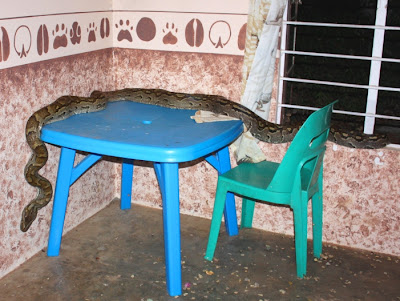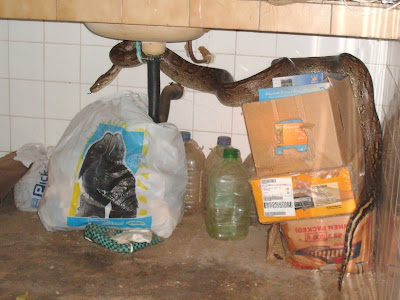Silence.
I lie wide-eyed staring into the dark. Apprehension edges through me as I strain to catch a tell-tale sound.
Directly over my head an innocent rodent has just met its doom.
And I don't know why (or more precisely, whom).
For the last couple of months my nights have been haunted by the slaughter in my ceiling. The piercing shrieks of dying bats, mice and geckos shatter my dreams.
Somewhere in my roof lurks a Large Predatory Beast. And, so far, I've been too cowardly to find out what it is.
 |
| Tomorrow's supper? An Egyptian slit-faced bat (Nycteris thebaica) hides out in my bathroom. |
While everyone's busy making New Year resolutions, I'm debating whether I should resolve to clamber up on my kitchen bench, clear away the cobwebs and poke my head up into the ceiling.
To look or not to look...
I know that as a wildlife enthusiast I should be bursting with curiosity and as a zoologist my scientific zeal should outweigh all other considerations. But I'm fairly certain The Beast is limb-free. And I do NOT like snakes. The tiny feet of mice and geckos hammer a noisy tattoo on my ceiling, and even visiting birds (shopping for nest sites) sound as if they're attending a tap-dance festival.
But when The Beast prowls, I hear nary a footfall.
Only one sound is detectable: a heavy, sliding slither. It's the sort of sound that, in the dead of night, conjures images of a hooded hunchback dragging his withered leg or a silent assassin gently shifting his kitbag.
I know you think I'm being paranoid. I'm mean lots of people have wildlife (even legless wildlife) living in the cosy space between ceiling and roof. But the problem is, only half my house has a proper ceiling. My lounge and kitchen are roofed with sagging sheets of thickened bubble-wrap, and each swayback strip - draped precariously over dangling wires – is bordered by big yawning gaps.
Call me wimpy, but I'm convinced that sooner or later - intentionally or otherwise – The Beast is going to drop down into my house.
Is it better, or worse, to know what's destined to land on your head?
The possible contenders are not encouraging. There are three nocturnal mammal-killers with a penchant for climbing: the snouted cobra, the African rock python and the brown house snake.
Snouted cobras scare the Hell out of me. They're the thugs of the cobra family. It isn't enough for them to tote a highly lethal neurotoxin, or to inject enough of it to kill ten humans. No, they also have to indulge in body-building. Why any cobra feels the need to attain boa-like proportions is beyond me, but when you're battling a snake phobia, it's just not nice.
As with most muscle-bound heavies, snouted cobras are active at night. Occasionally I meet one at dusk while walking my dogs at the local mine. Last time, the dogs were too busy haring after a duiker to notice the snake coiled by the track, but as I approached it reared up threateningly and spread its hood. Although quite reasonable in length (about 2 metres/6 feet), its yellowish body (banded here and there with grey) was as thick through as my thigh (the part toward the knee; I can't vouch for the rest after Xmas indulgences). The creature stood poised with its head at waist-height (I hate the way South African snakes do this; isn't there some biblical stricture about 'slithering on thy belly') and its massive hood was a scary 25 cm ( 10") across. I felt queasy. Hissing threateningly, it glared at me for a few moments before correctly concluding I was not a threat and gliding smoothly up into the canopy.
 |
| A captive snouted cobra showing off its glorious physique. Photo posted on Flickr by KBugler. |
To find out whether I was alone in my feelings towards the snouted cobra, I turned to the internet. The herpetological forums are a source of endless fascination for me. A snouted cobra photo that sends shivers down my spine elicits a volley of appreciative comments:
"I love this beautiful snake".
"One of my favourite species..."
"A stunning specimen of a gorgeous snake. I still miss Paul."
Huh?
The next comment, after a paragraph of snake-directed superlatives, concludes:
"Paul was a really great guy."
Yep, you guessed it. After a short search I find that Paul died several years ago after a snouted cobra nipped him on the wrist.
I do NOT understand snake-enthusiasts!
Of course, The Beast in my ceiling may turn out to be a non-venomous python. Unfortunately, the pythons around here grow a trifle large; husky-eating large. My neighbour, about 1.5 km downriver, recently found one 5.2 metres (17 feet) long showing a heart-warming interest in his Weimaraner dogs. Encountering one on my bed at 2 am has taught me that - venom or no venom - I do not want one of these falling on my head.
 |
| My guest room with guest. African rock python (Python sebae). |
There is no doubt, that the diminutive brown house snake (Lamprophis fuliginosus) is my one shining hope. It's small (about 1 m/3 ft) and its teeth are entirely venom-free. It even sounds reassuringly friendly; like a house cat.
Of course I've never actually seen one around here...
But maybe that's just evidence of its discrete and humble disposition.
Currently I remain unresolved.
Would you look?



























